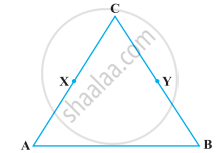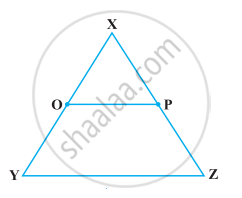Advertisements
Advertisements
प्रश्न
Solve the following question using appropriate Euclid’s axiom:
In the following figure, we have X and Y are the mid-points of AC and BC and AX = CY. Show that AC = BC.

उत्तर
Given, X is the mid-point of AC
AX = CX = `1/2` AC
⇒ 2AX = 2CX = AC ...(i)
And Y is the mid-point of BC.
BY = CY = `1/2` BC
⇒ 2BY = 2CY = BC ...(ii)
Also, given AX = CY ...(iii)
According to Euclid’s axiom, things which are double of the same things are equal to one another.
From equation (iii), 2AX = 2CY
⇒ AC = BC ...[From equation (i) and (ii)]
APPEARS IN
संबंधित प्रश्न
Consider two ‘postulates’ given below:-
- Given any two distinct points A and B, there exists a third point C which is in between A and B.
- There exist at least three points that are not on the same line.
Do these postulates contain any undefined terms? Are these postulates consistent? Do they follow from Euclid’s postulates? Explain.
In how many lines two distinct planes can intersect?
Given three distinct points in a plane, how many lines can be drawn by joining them?
The number of dimensions, a surface has ______.
It is known that if x + y = 10 then x + y + z = 10 + z. The Euclid’s axiom that illustrates this statement is ______.
Thales belongs to the country ______.
Which of the following needs a proof?
Solve the following question using appropriate Euclid’s axiom:
In the following figure, we have ∠1 = ∠3 and ∠2 = ∠4. Show that ∠A = ∠C.

Solve the following question using appropriate Euclid’s axiom:
In the following figure, if OX = `1/2` XY, PX = `1/2` XZ and OX = PX, show that XY = XZ.

The following statement is true or false? Give reason for your answer.
A terminated line can be produced indefinitely on both the sides.
